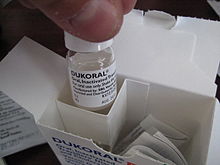 | |
| Vaccine description | |
|---|---|
| Target | Vibrio cholerae |
| Vaccine type | Inactivated |
| Clinical data | |
| Trade names | Dukoral, Vaxchora, others |
| AHFS/Drugs.com | Micromedex Detailed Consumer Information |
| License data | |
| Pregnancy category |
|
| Routes of administration | By mouth |
| ATC code | |
| Legal status | |
| Legal status | |
| Identifiers | |
| DrugBank | |
| ChemSpider |
|
| UNII | |
| KEGG | |
| | |
A cholera vaccine is a vaccine that is effective at reducing the risk of contracting cholera.[10] The recommended cholera vaccines are administered orally to elicit local immune response in the gut where the intestinal cells produce antibodies against the cholera microbe. This immune response was poorly achieved with the injectable vaccines that were used until the 1970s. The first effective oral cholera vaccine was Dukoral, developed in Sweden in the 1980s. For the first six months after vaccination it provides about 85% protection, which decreases to approximately 60% during the first two years.[10][11][12] When enough of the population is immunized, it may protect those who have not been immunized thereby increasing the total protective impact to more than 90 % (known as herd immunity).[10]
The World Health Organization (WHO) recommends the use of three oral cholera vaccines – Dukoral, Shanchol, and Euvichol-Plus – in combination with other measures among those at high risk for cholera.[10] Two vaccine doses with a 1–6 week interval are typically recommended.[10] The duration of protection is at least two years in adults and six months in children aged 1–5 years.[10] A live, attenuated single dose oral vaccine is available for those traveling to an area where cholera is common but is not WHO approved for public health use.[13][14][15]
The available types of oral cholera vaccine are generally considered safe for the majority of the population.[10] These vaccines were shown to be safe in pregnancy and in those with poor immune function.[10] The main side effects which could be experienced includes mild abdominal pain or diarrhea may occur.[10]
The first cholera vaccines were developed in the late 19th century.[16] They were the first widely used vaccine that was made in a laboratory but were largely abandoned in the 1970s due to their then documented reactogenicity and poor efficacy.[16]
Oral cholera vaccines were first introduced in the 1990s.[10] It is on the World Health Organization's List of Essential Medicines.[17][18]
These vaccines are licensed for use in more than 60 countries.[10] In countries where the disease is common, the vaccine appears to be cost effective.[10]
- ^ a b "Vaxchora APMDS". Therapeutic Goods Administration (TGA). 18 September 2023. Retrieved 7 March 2024.
- ^ "Summary for ARTG Entry:94483 Dukoral oral inactivated cholera vaccine liquid vial and buffer granules sachet". Therapeutic Goods Administration (TGA). Retrieved 30 July 2020.
- ^ "Dukoral Product information". Health Canada. 25 April 2012. Retrieved 30 July 2020.
- ^ "Dukoral suspension and effervescent granules for oral suspension, Cholera vaccine (inactivated, oral) – Summary of Product Characteristics (SmPC)". (emc). 7 December 2015. Retrieved 30 July 2020.
- ^ "Vaxchora – cholera vaccine, live, oral kit". DailyMed. 24 October 2018. Retrieved 30 July 2020.
- ^ "Vaxchora – cholera vaccine, live, oral kit". DailyMed. Retrieved 30 July 2020.
- ^ "Eukoral EPAR". European Medicines Agency (EMA). 17 September 2018. Retrieved 30 July 2020.
- ^ "Vaxchora EPAR". European Medicines Agency (EMA). 30 January 2020. Retrieved 30 July 2020.
- ^ "Vaxchora Product information". Union Register of medicinal products. Retrieved 3 March 2023.
- ^ a b c d e f g h i j k l "Cholera vaccines: WHO position paper – August 2017". Weekly Epidemiological Record. 92 (34): 477–498. August 2017. hdl:10665/258764. PMID 28845659.
- ^ Graves PM, Deeks JJ, Demicheli V, Jefferson T (August 2010). "Vaccines for preventing cholera: killed whole cell or other subunit vaccines (injected)". The Cochrane Database of Systematic Reviews. 2019 (8): CD000974. doi:10.1002/14651858.CD000974.pub2. PMC 6532721. PMID 20687062.
- ^ Sinclair D, Abba K, Zaman K, Qadri F, Graves PM (March 2011). "Oral vaccines for preventing cholera". The Cochrane Database of Systematic Reviews. 2011 (3): CD008603. doi:10.1002/14651858.CD008603.pub2. PMC 6532691. PMID 21412922.
- ^ "Vaxchora (Cholera vaccine, Live, Oral)". U.S. Food and Drug Administration. Archived (PDF) from the original on 1 March 2017. Retrieved 15 March 2017.
- ^ "Vaxchora approval letter" (PDF). U.S. Food and Drug Administration. 10 June 2016. Archived from the original (PDF) on 22 July 2017. Retrieved 30 July 2020.
 This article incorporates text from this source, which is in the public domain.
This article incorporates text from this source, which is in the public domain.
- ^ Cite error: The named reference
FDA Vaxchorawas invoked but never defined (see the help page). - ^ a b Stanberry LR (2009). Vaccines for biodefense and emerging and neglected diseases (1st ed.). Amsterdam: Academic. p. 870. ISBN 978-0-08-091902-7. Archived from the original on 8 September 2017.
- ^ Organization WH (2019). World Health Organization model list of essential medicines: 21st list 2019. Geneva: World Health Organization. hdl:10665/325771. WHO/MVP/EMP/IAU/2019.06. License: CC BY-NC-SA 3.0 IGO.
- ^ Organization WH (2021). World Health Organization model list of essential medicines: 22nd list (2021). Geneva: World Health Organization. hdl:10665/345533. WHO/MHP/HPS/EML/2021.02.